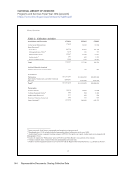35 SPEC Kit 352: Collection Assessment
Multiple people conduct analyses from throughout the organization.
Staff from different departments analyze data for collections that they manage, our selectors review
and analyze data in their collection areas, and our assessment librarian analyzes some collection data.
We also have a recently formed Collection Analysis Task Force that is working on collection analysis.
The Associate Dean for Collection Strategies has overall responsibility for data analysis, but many other
individuals contribute to analyses needed for specific projects. These may include senior members of
the Acquisitions Department as well as liaison librarians. The Acquisition Department reports to the
AD for Collections and the liaison librarians are dotted line reports.
The library’s Licensing &Acquisitions unit does most types of analysis for most types of resources. The
systems librarian does analysis of circulation data. Personnel in the library’s ILL unit does analysis for
ILL transactions.
The organizational structure for data analysis is handled by several individuals, a committee,
department heads, and administrators.
Various individuals in various libraries and departments analyze data about collections. These include
Collection Development, Assessment, Access Services, E-resources, Collection Management, and
Subject Librarians.
PURPOSE OF COLLECTION ASSESSMENT
34. For what purpose(s) are the collection assessments or evaluations initiated at your library? Check
all that apply. N=65
Collection development 62 95%
Library administration/other library-specific 57 88%
Accreditation review (program, department, or school level) 46 71%
New program reviews 39 60%
Accreditation review (college/university level) 37 57%
Internal academic reviews of programs 31 48%
Initiate development of a shared collection 30 46%
Establish criteria for collection selection digitization 24 37%
Evaluate shared collection strategy effectiveness 24 37%
Other purpose 23 35%
Please briefly describe the other purpose. N=23
Ad hoc basis driven by needs of the Libraries (e.g., strategic use of space) involves subject specialists,
collections, and technical services and institutional overviews.
Annual reporting to institution leadership and Congress
Budget savings
Efficiency (de-duplication process), faculty support and promotion, budgeting, organizational
promotion, strategic plan initiatives
Fiscal constraints, space constraints
Good stewardship
Multiple people conduct analyses from throughout the organization.
Staff from different departments analyze data for collections that they manage, our selectors review
and analyze data in their collection areas, and our assessment librarian analyzes some collection data.
We also have a recently formed Collection Analysis Task Force that is working on collection analysis.
The Associate Dean for Collection Strategies has overall responsibility for data analysis, but many other
individuals contribute to analyses needed for specific projects. These may include senior members of
the Acquisitions Department as well as liaison librarians. The Acquisition Department reports to the
AD for Collections and the liaison librarians are dotted line reports.
The library’s Licensing &Acquisitions unit does most types of analysis for most types of resources. The
systems librarian does analysis of circulation data. Personnel in the library’s ILL unit does analysis for
ILL transactions.
The organizational structure for data analysis is handled by several individuals, a committee,
department heads, and administrators.
Various individuals in various libraries and departments analyze data about collections. These include
Collection Development, Assessment, Access Services, E-resources, Collection Management, and
Subject Librarians.
PURPOSE OF COLLECTION ASSESSMENT
34. For what purpose(s) are the collection assessments or evaluations initiated at your library? Check
all that apply. N=65
Collection development 62 95%
Library administration/other library-specific 57 88%
Accreditation review (program, department, or school level) 46 71%
New program reviews 39 60%
Accreditation review (college/university level) 37 57%
Internal academic reviews of programs 31 48%
Initiate development of a shared collection 30 46%
Establish criteria for collection selection digitization 24 37%
Evaluate shared collection strategy effectiveness 24 37%
Other purpose 23 35%
Please briefly describe the other purpose. N=23
Ad hoc basis driven by needs of the Libraries (e.g., strategic use of space) involves subject specialists,
collections, and technical services and institutional overviews.
Annual reporting to institution leadership and Congress
Budget savings
Efficiency (de-duplication process), faculty support and promotion, budgeting, organizational
promotion, strategic plan initiatives
Fiscal constraints, space constraints
Good stewardship




















































































































































































